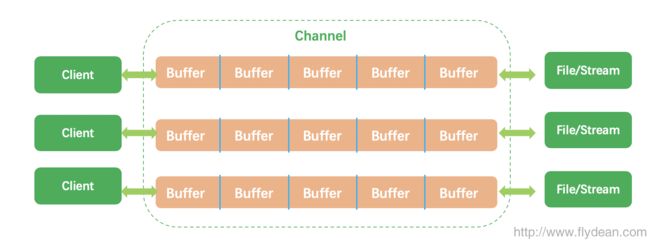小师妹学JavaIO之:NIO中Channel的妙用
文章目录
- 简介
- Channel的分类
- FileChannel
- Selector和Channel
- DatagramChannel
- SocketChannel
- ServerSocketChannel
- AsynchronousSocketChannel
- 使用Channel
- 总结
简介
小师妹,你还记得我们使用IO和NIO的初心吗?
小师妹:F师兄,使用IO和NIO不就是为了让生活更美好,世界充满爱吗?让我等程序员可以优雅的将数据从一个地方搬运到另外一个地方。利其器,善其事,才有更多的时间去享受生活呀。
善,如果将数据比做人,IO,NIO的目的就是把人运到美国。
小师妹:F师兄,为什么要运到美国呀,美国现在新冠太严重了,还是待在中国吧。中国是世界上最安全的国家!
好吧,为了保险起见,我们要把人运到上海。人就是数据,怎么运过去呢?可以坐飞机,坐汽车,坐火车,这些什么飞机,汽车,火车就可以看做是一个一个的Buffer。
最后飞机的航线,汽车的公路和火车的轨道就可以看做是一个个的channel。
更多精彩内容且看:
- 区块链从入门到放弃系列教程-涵盖密码学,超级账本,以太坊,Libra,比特币等持续更新
- Spring Boot 2.X系列教程:七天从无到有掌握Spring Boot-持续更新
- Spring 5.X系列教程:满足你对Spring5的一切想象-持续更新
- java程序员从小工到专家成神之路(2020版)-持续更新中,附详细文章教程
简单点讲,channel就是负责运送Buffer的通道。
IO按源头来分,可以分为两种,从文件来的File IO,从Stream来的Stream IO。不管哪种IO,都可以通过channel来运送数据。
Channel的分类
虽然数据的来源只有两种,但是JDK中Channel的分类可不少,如下图所示:
![]()
先来看看最基本的,也是最顶层的接口Channel:
public interface Channel extends Closeable {
public boolean isOpen();
public void close() throws IOException;
}
最顶层的Channel很简单,继承了Closeable接口,需要实现两个方法isOpen和close。
一个用来判断channel是否打开,一个用来关闭channel。
小师妹:F师兄,顶层的Channel怎么这么简单,完全不符合Channel很复杂的人设啊。
别急,JDK这么做其实也是有道理的,因为是顶层的接口,必须要更加抽象更加通用,结果,一通用就发现还真的就只有这么两个方法是通用的。
所以为了应对这个问题,Channel中定义了很多种不同的类型。
最最底层的Channel有5大类型,分别是:
FileChannel
这5大channel中,和文件File有关的就是这个FileChannel了。
FileChannel可以从RandomAccessFile, FileInputStream或者FileOutputStream中通过调用getChannel()来得到。
也可以直接调用FileChannel中的open方法传入Path创建。
public abstract class FileChannel
extends AbstractInterruptibleChannel
implements SeekableByteChannel, GatheringByteChannel, ScatteringByteChannel
我们看下FileChannel继承或者实现的接口和类。
AbstractInterruptibleChannel实现了InterruptibleChannel接口,interrupt大家都知道吧,用来中断线程执行的利器。来看一下下面一段非常玄妙的代码:
protected final void begin() {
if (interruptor == null) {
interruptor = new Interruptible() {
public void interrupt(Thread target) {
synchronized (closeLock) {
if (closed)
return;
closed = true;
interrupted = target;
try {
AbstractInterruptibleChannel.this.implCloseChannel();
} catch (IOException x) { }
}
}};
}
blockedOn(interruptor);
Thread me = Thread.currentThread();
if (me.isInterrupted())
interruptor.interrupt(me);
}
上面这段代码就是AbstractInterruptibleChannel的核心所在。
首先定义了一个Interruptible的实例,这个实例中有一个interrupt方法,用来关闭Channel。
然后获得当前线程的实例,判断当前线程是否Interrupted,如果是的话,就调用Interruptible的interrupt方法将当前channel关闭。
SeekableByteChannel用来连接Entry或者File。它有一个独特的属性叫做position,表示当前读取的位置。可以被修改。
GatheringByteChannel和ScatteringByteChannel表示可以一次读写一个Buffer序列结合(Buffer Array):
public long write(ByteBuffer[] srcs, int offset, int length)
throws IOException;
public long read(ByteBuffer[] dsts, int offset, int length)
throws IOException;
Selector和Channel
在讲其他几个Channel之前,我们看一个和下面几个channel相关的Selector:
这里要介绍一个新的Channel类型叫做SelectableChannel,之前的FileChannel的连接是一对一的,也就是说一个channel要对应一个处理的线程。而SelectableChannel则是一对多的,也就是说一个处理线程可以通过Selector来对应处理多个channel。
SelectableChannel通过注册不同的SelectionKey,实现对多个Channel的监听。后面我们会具体的讲解Selector的使用,敬请期待。
DatagramChannel
DatagramChannel是用来处理UDP的Channel。它自带了Open方法来创建实例。
来看看DatagramChannel的定义:
public abstract class DatagramChannel
extends AbstractSelectableChannel
implements ByteChannel, ScatteringByteChannel, GatheringByteChannel, MulticastChannel
ByteChannel表示它同时是ReadableByteChannel也是WritableByteChannel,可以同时写入和读取。
MulticastChannel代表的是一种多播协议。正好和UDP对应。
SocketChannel
SocketChannel是用来处理TCP的channel。它也是通过Open方法来创建的。
public abstract class SocketChannel
extends AbstractSelectableChannel
implements ByteChannel, ScatteringByteChannel, GatheringByteChannel, NetworkChannel
SocketChannel跟DatagramChannel的唯一不同之处就是实现的是NetworkChannel借口。
NetworkChannel提供了一些network socket的操作,比如绑定地址等。
ServerSocketChannel
ServerSocketChannel也是一个NetworkChannel,它主要用在服务器端的监听。
public abstract class ServerSocketChannel
extends AbstractSelectableChannel
implements NetworkChannel
AsynchronousSocketChannel
最后AsynchronousSocketChannel是一种异步的Channel:
public abstract class AsynchronousSocketChannel
implements AsynchronousByteChannel, NetworkChannel
为什么是异步呢?我们看一个方法:
public abstract Future<Integer> read(ByteBuffer dst);
可以看到返回值是一个Future,所以read方法可以立刻返回,只在我们需要的时候从Future中取值即可。
使用Channel
小师妹:F师兄,讲了这么多种类的Channel,看得我眼花缭乱,能不能讲一个Channel的具体例子呢?
好的小师妹,我们现在讲一个使用Channel进行文件拷贝的例子,虽然Channel提供了transferTo的方法可以非常简单的进行拷贝,但是为了能够看清楚Channel的通用使用,我们选择一个更加常规的例子:
public void useChannelCopy() throws IOException {
FileInputStream input = new FileInputStream ("src/main/resources/www.flydean.com");
FileOutputStream output = new FileOutputStream ("src/main/resources/www.flydean.com.txt");
try(ReadableByteChannel source = input.getChannel(); WritableByteChannel dest = output.getChannel()){
ByteBuffer buffer = ByteBuffer.allocateDirect(1024);
while (source.read(buffer) != -1)
{
// flip buffer,准备写入
buffer.flip();
// 查看是否有更多的内容
while (buffer.hasRemaining())
{
dest.write(buffer);
}
// clear buffer,供下一次使用
buffer.clear();
}
}
}
上面的例子中我们从InputStream中读取Buffer,然后写入到FileOutputStream。
总结
今天讲解了Channel的具体分类,和一个简单的例子,后面我们会再体验一下Channel的其他例子,敬请期待。
本文的例子https://github.com/ddean2009/learn-java-io-nio
本文作者:flydean程序那些事
本文链接:http://www.flydean.com/java-io-nio-channel/
本文来源:flydean的博客
欢迎关注我的公众号:程序那些事,更多精彩等着您!

